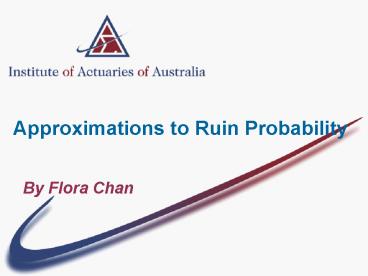Approximations to Ruin Probability
1 / 30
Title:
Approximations to Ruin Probability
Description:
4 equations, 4 unknowns solve simultaneously for 1, 2, R1 and R2 for ... Involves solving quadratic equations. Constraints on parameters chosen for p(x) ... –
Number of Views:140
Avg rating:3.0/5.0
Title: Approximations to Ruin Probability
1
Approximations to Ruin Probability
- By Flora Chan
2
Outline
- Research objectives and motivations
- Background knowledge
- Different methods of approximation
- Applications on two claims distributions
- Comparison and analysis of the various methods
3
Research Objectives
- Closed form solutions to ruin probabilities are
not always possible - Investigate 4 methods of approximating ruin
probabilities - Matching Moments
- Modified De Vylders Approximation
- Tijms Approximation
- Original De Vylders Approximation
4
Classical Risk Model (1)
- Surplus process U(t)t0
- u is the initial surplus
- c is the rate of premium income per time unit
- N(t) is the number of claims up to time t
- Xi is the amount of the i-th claim
5
Classical Risk Model (2)
- Total number of claims up to time t, N(t)t0 is
a Poisson process with parameter ? - Aggregate claims process, S(t)t0,
- is a compound Poisson process with Poisson
parameter ?
6
Classical Risk Model (3)
- Premium loading
- c (1?) ? p1 (pk E(Xki))
- Probability of ruin, ?(u)
7
Maximum Aggregate Loss (1)
- Aggregate loss process, L(t)t0
- Maximum aggregate loss, L
- Relationship between ?(u) and L
- i.e. ?(u) gives the tail probability of L
8
Maximum Aggregate Loss (2)
- L is the sum of individual new record highs of
L(t) - Process has stationary and independent
increments, hence probability of each record high
is the same - L follows a compound geometric distribution with
q ?(0) 1/(1?)
9
Maximum Aggregate Loss (3)
10
Approximations to ?(u)
- Propose a two-term exponential function as ?(u)
- Commonly used one-term exponential approximation
- Lundbergs inequality
- Cramers asymptotic formula
11
Matching Moments (1)
- Derive the first three moments of the max. agg.
loss r.v. L in 2 ways - Direct computation of n-th moment by
- where Pr(Lgtx) is given by ?(u)
- E(L), E(L2) and E(L3) in terms of ?1, ?2, R1 and
R2.
12
Matching Moments (2)
- View L as sum of record highs
- n-th moment of Li depends on moments of
individual claims distribution pn1 - Apply Panjers recursion formula since L is
compound geometric - E(L), E(L2) and E(L3) in terms of p1, p2, p3, p4
and ?
13
Matching Moments (3)
- Note that
- 4 equations, 4 unknowns ? solve simultaneously
for ?1, ?2, R1 and R2 for particular values of ?
14
Matching Moments (4)
- Does not involve complicated computations
- Easily solved using spreadsheets
- Only first 3 moments are required
- Obtain from past claims data
- Involves solving quadratic equations
- Constraints on parameters chosen for p(x)
- Applies to most claims distributions
15
Original De Vylders Method
- Define a new classical risk process with Poisson
parameter , and individual claims - Approximate ?(u) by
- Parameters can be determined by characteristic
functions of the two surplus processes
16
Modified De Vylder (1)
- Similar to the original method, but new classical
risk process has two-term mixed exponential
individual claims distribution - where ? 1 ?2 1, ?1, ?2 gt 0.
- Equate characteristic functions of two surplus
processes
17
Modified De Vylder (2)
- Approximation adopts new Poisson parameter ?
and loading factor - ? 6 unknowns
- Note that ?1 ?2 1, need first 5 terms in
characteristic functions - ? 6 equations, 6 unknowns
- Solve simultaneously
18
Modified De Vylder (3)
- Does not involve complicated computations
- Easily solved using spreadsheets
- One more moment is required
- Different surplus process in approximation
- Involves solving quadratic equations
- Constraints on parameters chosen for p(x)
- Applies to most claims distributions
19
Tijms Approximation
- Approximate ?(u) by
- where
- C is calculated as in Cramers asymptotic formula
- R is the adjustment coefficient
- R1 is chosen by matching the first moment of L
20
Numerical Illustration (1)
- Two individual claims distribution
- 3-term mixed exponential function
- P(x) 1 - 0.0039793e-0.014631x
- - 0.1078392e-0.190206x
- - 0.8881815e-5.514588x
- 2. Gamma distribution
- p(x) ?? x?-1e-?x/?(?), ?, ? 0.1
21
Numerical Illustration (2)
Properties of the distributions
22
Numerical Illustration (3)
- Five methods of computing ?(u)
- Exact calculation
- Method of Matching Moments
- Modified De Vylders Approximation
- Tijms Approximation
- Original De Vylders Approximation
- Example ? 0.5, ? 1
23
Distribution 1 (1)
24
Distribution 1 (2)
- ?(u) for different methods
25
Distribution 1 (3)
- General conclusions
- Quality of approximation improves as initial
surplus relative to the first moment increases - Changing loading factor does not affect
performance - Method (3) gives the best approximation of ?(u)
- Method (2) and (4) gives similar results
- Method (5) has the worst performance
26
Distribution 2 (1)
27
Distribution 2 (2)
- ?(u) for different methods
28
Distribution 2 (3)
- General conclusions
- Distribution has low variance, ?(u) quickly goes
to 0 - All four methods perform equally well
- As initial surpluses increase, approximations
quickly approach the exact values
29
Summary (1)
- The method of matching moments and modified De
Vylders approximation can be applied to many
kinds of distributions - Tijms approximation only exists when m.g.f.
exists - e.g. not for Lognormal, Pareto
30
Summary (2)
- Quality of approximation
- Modified De Vylders method performs relatively
better than the others - Method of matching moments and Tijms
approximation give similar results - Approximations improve as initial surplus
increases - Poor approximation for heavy-tailed distributions
(for those without m.g.f.)































